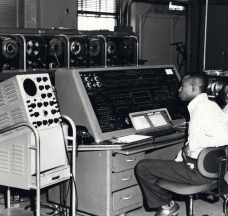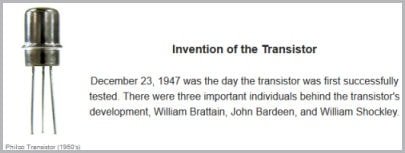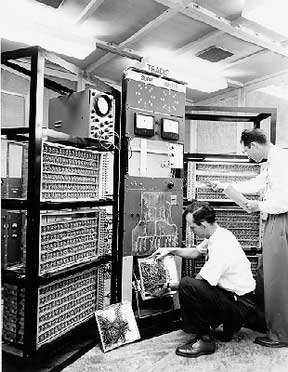IThe first generation of computer
First Generation: Vacuum Tubes (1940-1956)
The first computer systems used vacuum tubes for circuitry and magnetic drums for memory, and were often enormous, taking up entire rooms. These computers were very expensive to operate and in addition to using a great deal of electricity, the first computers generated a lot of heat, which was often the cause of malfunctions.
First generation computers relied on machine language , the lowest-level programming language understood by computers, to perform operations, and they could only solve one problem at a time. It would take operators days or even weeks to set-up a new problem. Input was based on punched cards and paper tape, and output was displayed on printouts.
The UNIVAC and ENIAC computers are examples of first-generation computing devices. The UNIVAC was the first commercial computer delivered to a business client, the U.S. Census Bureau in 1951. A UNIVAC computer at the Census Bureau.
A UNIVAC computer at the Census Bureau.
Image Source: United States Census Bureau
Second Generation: Transistors (1956-1963)
The world would see transistors replace vacuum tubes in the second generation of computers. The transistor was invented at Bell Labs in 1947 but did not see widespread use in computers until the late 1950s.
The transistor was far superior to the vacuum tube, allowing computers to become smaller, faster, cheaper, more energy-efficient and more reliable than their first-generation predecessors. Though the transistor still generated a great deal of heat that subjected the computer to damage, it was a vast improvement over the vacuum tube. Second-generation computers still relied on punched cards for input and printouts for output.
From Binary to Assembly
Second-generation computers moved from cryptic
binary machine language to symbolic, or assembly , languages, which allowed programmers to specify instructions in words. High-level programming languages were also being developed at this time, such as early versions of COBOL and FORTRAN . These were also the first computers that stored their instructions in their memory, which moved from a magnetic drum to magnetic core technology.
The first computers of this generation were developed for the atomic energy industry.
Third Generation: Integrated Circuits
(1964-1971)
The development of the integrated circuit was the hallmark of the third generation of computers. Transistors were miniaturized and placed on silicon
chips, called semiconductors , which drastically increased the speed and efficiency of computers.
Instead of punched cards and printouts, users interacted with third generation computers through
keyboards and monitors and interfaced with an
operating system , which allowed the device to run many different applications at one time with a central program that monitored the memory. Computers for the first time became accessible to a mass audience because they were smaller and cheaper than their predecessors.
Did You Know... ? An integrated circuit (IC) is a small electronic device made out of a semiconductor material. The first integrated circuit was developed in the 1950s by Jack Kilby of Texas Instruments and Robert Noyce of Fairchild Semiconductor.
Fourth Generation: Microprocessors (1971-Present)
The microprocessor brought the fourth generation of computers, as thousands of integrated circuits were built onto a single silicon chip. What in the first generation filled an entire room could now fit in the palm of the hand. The Intel 4004 chip, developed in 1971, located all the components of the computer—from the central processing unit and memory to input/output controls—on a single chip.
In 1981 IBM introduced its first computer for the home user, and in 1984 Apple introduced the Macintosh. Microprocessors also moved out of the realm of desktop computers and into many areas of life as more and more everyday products began to use microprocessors.
As these small computers became more powerful, they could be linked together to form networks, which eventually led to the development of the Internet. Fourth generation computers also saw the development of GUIs , the mouse and handheld devices.Fifth Generation: Artificial Intelligence (Present and Beyond)
Fifth generation computing devices, based on artificial intelligence , are still in development, though there are some applications, such as voice recognition , that are being used today. The use of parallel processing and superconductors is helping to make artificial intelligence a reality.
Quantum computation and molecular and
nanotechnology will radically change the face of computers in years to come. The goal of fifth-generation computing is to develop devices that respond to natural language input and are capable of learning and self-organization.The period of first generation was from 1946-1959. The computers of first generation used vacuum tubes as the basic components for memory and circuitry for CPU (Central Processing Unit). These tubes, like electric bulbs, produced a lot of heat and the installations used to fuse frequently. Therefore, they were very expensive and only large organizations were able to afford it.
In this generation, mainly batch processing operating system was used. Punch cards, paper tape, and magnetic tape was used as input and output devices. The computers in this generation used machine code as the programming language The main features of the first generation are −
The main features of the first generation are −
Vacuum tube technology
Unreliable
Supported machine language only
Very costly
Generated a lot of heat
Slow input and output devices
Huge size
Need of AC
Non-portable
Consumed a lot of electricity
Some computers of this generation were −
ENIAC
EDVAC
UNIVAC
IBM-701
IBM-650
Facts about the first generation computer
First Generation computer (1942-1955)
The early computer and other of their time were manufactured using vacuum tubes as electronic switching device. A vacuum tube was a fragile glass device using filament as a source of electronic and could control and amplify electronic signals. It was the only high – speed electronic switching device available in those days. These vacuum tube computers could perform computations in milliseconds and were known as First generation computers.
Most of the first-generation computers worked on the principle of storing program instructions along with data in memory of computers (stored program concept) so they could automatically execute a program without human intervention. Memory of these computers used electromagnetic relays, and users fed all data and instructions into the system using punched cards. Programmers wrote instructions in machine and assembly languages because of lack of high-level programming languages in those days. Since machine and assembly languages are difficult to work with, only a few specialists understood how to program these early computers.
Characteristic features of first generation computers are as follows:
- They were the fastest calculating device of their time.
- These generation computers were too bulky in size , requiring large rooms for installation.
- They used thousands of vacuum tubes that emitted large amount of heat and burnt out frequently.
- Each vaccum tube consumef about a half a watt of power. Since a computer typically used more than ten thousand vacuum tubes, power consumption of these computers was very high.
- As vaccum tubes used filaments, they had a limited life. Because a computer used thousands of vacuum tubes, these computers were prone to frequent hardware failures.
- Due to low mean time between failures, these computers required constant maintenance
- Commercial production of these computers was difficult and costly.
- Since these computers were difficult to program and use, they had limited commercial use.

Welcome to steemit!
I am a bot built for the purposes of welcoming new users! You are receiving this message as you have used the #introduceyourself tag! I know that steemit may seem very overwhelming to you right now but don't worry. There's a learning curve to everything so just be patient and you'll be churning out posts and becoming a part of something great in no time!
Also if there are any questions that you may have, then just ask your questions on any of my blog posts and I'll be more than happy to assist you with whatever questions you may have! I will also be creating a basic starting out guide for all minnows and newcomers on my blog so do give it a read as that might help answer many of your questions!
Have fun and I wish you LOADS of success on here! :)
Also. you can call upon originalworks whenever something you post is your own content like this: @originalworks
Regards
@welcome-to-steem
Welcome steem family :)
This comment has received a 0.04 % upvote from @speedvoter thanks to: @swati06.
Unwashed Human, this post does not belong under the introduceyourself or introducemyself tag. Please cease abusing this tag immediately.
This post also looks plagiarised, don't forget the importance of providing references for where you took your information and images from.